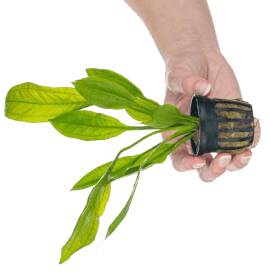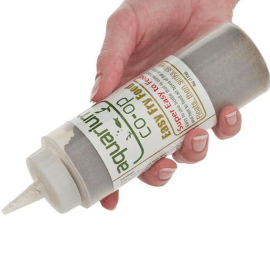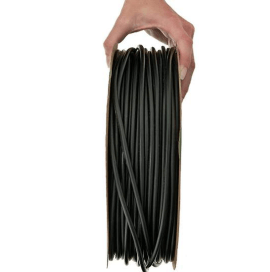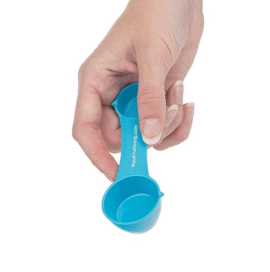10 Best Top-Dwelling Fish for Your Aquarium
Bottom dwellers are quite popular because they cruise around the bottom of the fish tank and clean up any food scraps from the ground. To balance out your aquarium, try adding some top-dwelling fish that will feed from the surface and fill the upper third of your fish tank.
1. Brown Pencilfish
A cheap and easy surface dweller to start off our list is Nannostomus eques, also known as the hockeystick or diptail pencilfish. Their common names came from their slanted swimming style in which the head points toward the surface and the tail dips down at a 45-degree angle. They like to drift along the surface looking for tiny foods (like crushed up flakes or baby brine shrimp), so avoid having high flow near the top of the aquarium. As a docile schooling fish, they feel most comfortable in a group of six or more brown pencilfish and readily get along with other peaceful community fish of similar size. For more information, read our full article on pencilfish.

Brown pencilfish
2. Silver Hatchetfish
If you naturally gravitate toward oddball fish, take a look at Gasteropelecus sternicla. Their body is shiny silver, narrow, and curved like the blade part of a hatchet. They tend to surf around the water surface with their fins out like little wings, looking for small foods floating up top. As with most surface dwellers in this list, they are excellent jumpers and always seem to find the smallest crack in your aquarium top to leap out of. Because many of them are wild-caught specimens, make sure you get a group of at least six silver hatchetfish that are not malnourished, and consider proactively treating them for ich or white spot disease.

Silver hatchetfish
3. Golden Wonder Killifish
Not all surface dwellers have to be schooling fish. Aplocheilus lineatus is a gorgeous (and hardy) centerpiece fish that gets up to 4 inches (10 cm) long. The male is more colorful and has a brilliant yellow body with a blue-green sheen and orange edging on its tail and fins. Like many killifish, they enjoy slightly cooler temperatures between 72-78°F (22-26°C) and require a snug lid without any gaps around the power cables and airline tubing. This larger species enjoys meaty foods like bloodworms and brine shrimp, so don’t keep them with any tiny fish that can fit in their big mouths. Also, they can be a little aggressive towards each other, so keep more females than males and introduce lots of obstacles (like floating plants) to block line of sight.

Golden wonder killifish or striped panchax
4. African Butterflyfish
Pantodon buchholzi is another oddball surface dweller that looks like a miniature arowana with large wings and spiky fins. Growing up to 5 inches (13 cm) in length, the freshwater butterfly fish belongs in a 30-gallon or larger aquarium with no small tank mates. As an ambush predator, they prefer slow-moving waters and a nutrient-rich diet of floating foods like freeze-dried krill and frozen foods. They can be a little aggressive towards other surface-dwelling species (especially their own kind), so either get just one butterflyfish or keep a small group with a dense mass of floating plants as shelter.

African butterflyfish
5. Furcata Rainbowfish
Pseudomugil furcatus is one of our favorite dwarf rainbowfish with bright blue eyes and yellow-tipped fins that look like little pom-poms waving in the air. They’re very fast and eat almost anything, so don’t mix them with slower fish like long-tailed guppies that might get outcompeted during mealtimes. Because these rainbowfish are a bit pricier than your average 2-inch (5 cm) fish and have a shorter lifespan of 2-3 years, consider getting a school of six and breeding them using spawning mops and a separate fry grow-out tank. For more info, see our detailed care guide on forktail rainbows.

Forktail blue-eye or furcata rainbowfish
6. Betta Fish
We can’t forget about the most popular beginner fish, Betta splendens. Yes, bettas will technically swim all over the aquarium, but if your tank is set up correctly, they do prefer to hang out in the upper third level. The key is to create more “perches” and resting posts up top, such as a floating betta log, betta leaf hammock, floating plants, or a live plant with board leaves that reach the surface (like an Amazon sword or large anubias). Feed them a varied diet of frozen bloodworms, freeze-dried brine shrimp, and betta pellets. For more information on betta fish care requirements and potential tank mates, read our complete care guide here.

Dumbo halfmoon betta fish
7. Common Danio
“Common” danios refer to zebra, leopard, blue, and other fast-paced danios with a narrow, torpedo-shaped body. They can swim at all levels but tend to hang out near the top, actively looking for any type of food to drop in. This schooling fish prefers a group of six or more and does great in cooler water fish tanks around 72-74°F (22-23°C). Beginner and veteran fish keepers alike enjoy keeping an action-packed tank full of these hardy, energetic fish.

Leopard danio
8. Clown Killifish
Epiplatys annulatus is a colorful nano fish with striking vertical bands, piercing blue eyes, and a flaming tail of orange, yellow, or red that inspires its other nickname “rocket killifish.” Like other killifish, it needs a close-fitting top to prevent escape and can live in cooler temperatures from 74-76°F (23-24°C). Unlike the golden wonder killi, clown killifish are much tinier and stay less than 1.5 inches (3.8 cm) in length. Get at least six to eight clown killis in a school, and feed them very small foods like micro granules, crushed flakes, cyclops, and baby brine shrimp. While they are not annual killifish, they do have a shorter life span of around three years, so you can try to breed them in a species-only tank with spawning mops or floating plants to collect the eggs.

Male and female clown killifish
9. Orange Hatchet Danio
Laubuka dadiburjori (formerly called Chela dadiburjori) is a different kind of danio with a slightly rounded, more hatchet-shaped belly compared to your typical zebrafish. Its shiny orange body has a distinct horizontal stripe running down the side made of several black spots in a row. Like the common danios, they like to swim near the surface, will eat almost anything, and can live in cooler water temperatures. If you’re looking for a rarer danio to try, get six or more in a pack, and enjoy their speedy chases around the fish tank.
10. Halfbeak
This group of livebearers is known for its unusual mouth shape where the lower jaw is longer than the upper jaw. Some halfbeak species require brackish water, so do your research and stick with the Celebes, silver, and golden halfbeaks for freshwater only tanks. They do grow large enough to eat smaller fish and their own fry, so provide lots of floating plants and cover to increase fry survival rate and minimize squabbling among males. Sometimes they don’t get enough food at the wholesalers or fish stores, so fatten them up with plenty of small, meaty foods like daphnia and bloodworms.

Celebes halfbeak (Nomorhamphus liemi)
If you spot a top-dwelling fish you like, check out our preferred online fish vendors and see what they have in stock. Enjoy nature daily, and make sure to get that tight-fitting aquarium lid.




